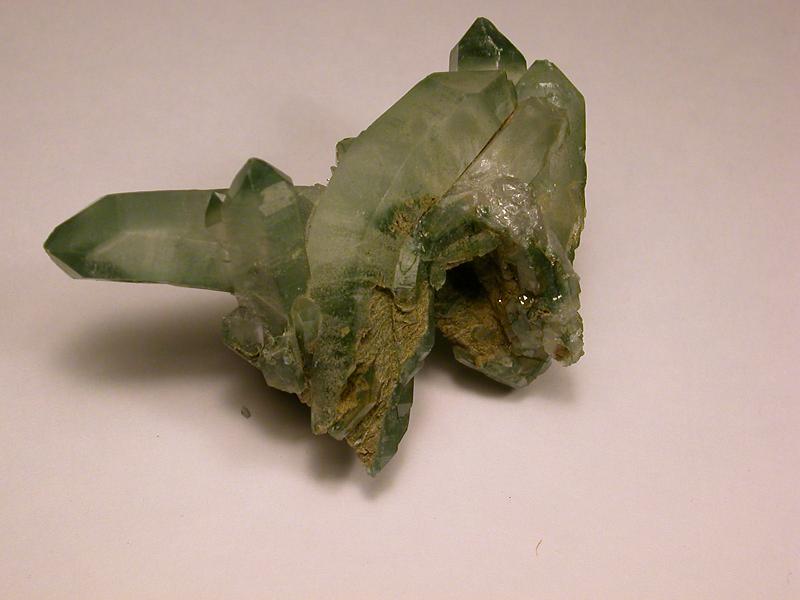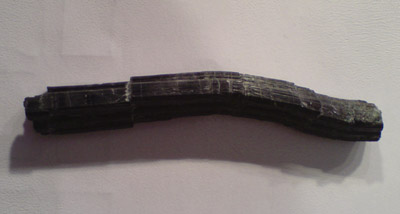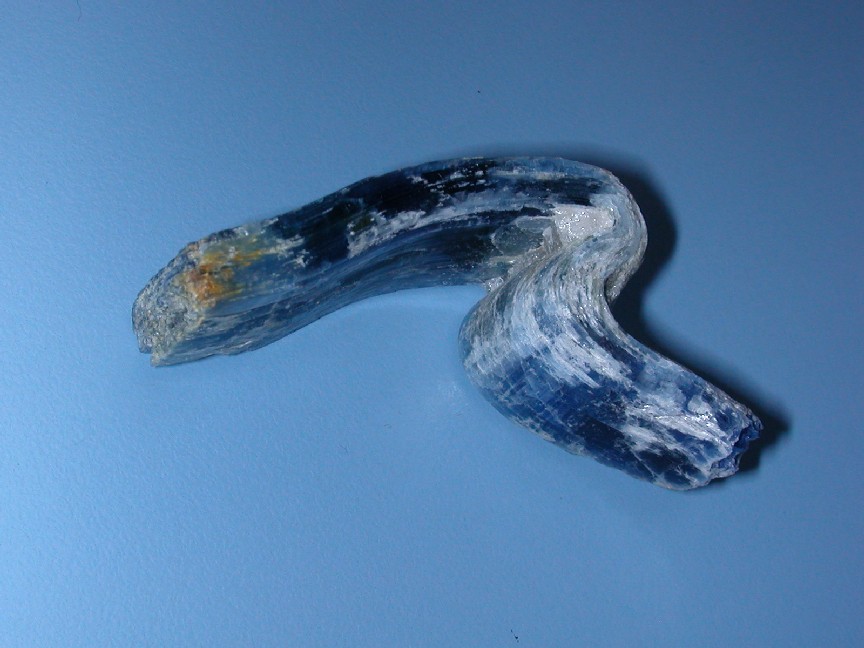| View previous topic :: View next topic |
| Author |
Message |
John S. White
Site Admin

Joined: 04 Sep 2006
Posts: 1298
Location: Stewartstown, Pennsylvania, USA



|
 Posted: Mar 08, 2007 10:23 Post subject: Curved crystals Posted: Mar 08, 2007 10:23 Post subject: Curved crystals |
|
|
So, to get things started let us consider the wonder of curved crystals, in particular quartz crystals, such as that shown in the specimen from the Chivor mine, Colombia (I apologize for the poor photo). It literally boggles the mind that one out of a group of normal crystals can evolve with such a profound curvature, almost as though it had melted and drooped much like a candle. This is not what happened, of course, but I am at a loss to explain what actually made this crystal curved and so different from its neighbors. This example is far from unique, I have seen many more quartz crystals with similar bends in them sitting right next to perfectly normal ones. The curvature on this one seems to be more profound, however, than what one usually sees with quartz.
Quartz is also famous for curving in another manner. The famous twisted crystals (gwindels) that have been found in impressive numbers in the Alpine veins of Switzerland are very well known, with far more rare examples having been found elsewhere. These are, for the most part, always dark smoky in color. Many matrix specimens have been recovered wherein the gwindels are attached to the matirx along prism faces by one end of the twisted a axis yet the neighboring "normal" crystals are attached to the matrix at the base at the c axis. There are also examples of gwindels twisted about the c axis that are attached to the base at the c axis. And, of course, there are also right- and left-handed twisted gwindels.
Other minerals exhibit curving of crystals as well, especially many of the carbonate species. Dolomite is particularly famous for appearing in what are called “saddle-shaped” crystals, but I have no examples to describe and illustrate.
Perhaps someone out there can help us to understand this strange phenomenon of curving and twisting. I cannot.
| Description: |
|
| Viewed: |
69475 Time(s) |

|
_________________
John S. White
aka Rondinaire |
|
| Back to top |
|
 |
Jordi Fabre
Overall coordinator of the Forum

Joined: 07 Aug 2006
Posts: 5090
Location: Barcelona



|
 Posted: Mar 09, 2007 04:33 Post subject: Re: Curved crystals Posted: Mar 09, 2007 04:33 Post subject: Re: Curved crystals |
|
|
John,
I ignore also the reason why this strange phenomenon of curving twisting happens. Hopefully someone out could help, but on the meantime I publish also the photo of a really curved Schorl that I got in Tucson. On this case we can see on it broken parts recrystallized later, so I assume that it means that the torsion was brutal, arriving to broke this solid Schorl crystal.
Jordi
| Description: |
| Curved and recrystallized Schorl from Pakistan |
|
| Viewed: |
69415 Time(s) |

|
|
|
| Back to top |
|
 |
John S. White
Site Admin

Joined: 04 Sep 2006
Posts: 1298
Location: Stewartstown, Pennsylvania, USA



|
 Posted: Mar 11, 2007 11:10 Post subject: Curved crystals Posted: Mar 11, 2007 11:10 Post subject: Curved crystals |
|
|
Hi Jordi:
I am sure you realize that the curved tourmaline you illustrated had a very different history than the curved quartz that I illustrated. The tourmaline was subjected to tectonic forces within the crust of the earth that caused it to break and reheal, probably well after having been completely formed. In the case of the curved (chlorite included, which I forgot to mention) quartz from Colombia, this crystal decided it wanted to grow that way on its own, it was not made to curve by external forces. At least that is what I believe.
John
_________________
John S. White
aka Rondinaire |
|
| Back to top |
|
 |
John S. White
Site Admin

Joined: 04 Sep 2006
Posts: 1298
Location: Stewartstown, Pennsylvania, USA



|
 Posted: Mar 12, 2007 04:32 Post subject: Curved and deformed crystals Posted: Mar 12, 2007 04:32 Post subject: Curved and deformed crystals |
|
|
Hi Jordi:
Here is an example of an extremely deformed crystal. But unlike your tourmaline, this crystal must have been plastic when it was folded because it shows no evidence of breaking and rehealing. This wonderful kyanite is from Barra do Salinas, Minas Gerais, Brazil and I acquired it at the 2006 Munich Mneral Show.
John S. White
| Description: |
|
| Viewed: |
69495 Time(s) |

|
_________________
John S. White
aka Rondinaire |
|
| Back to top |
|
 |
Jordi Fabre
Overall coordinator of the Forum

Joined: 07 Aug 2006
Posts: 5090
Location: Barcelona



|
 Posted: Mar 12, 2007 07:47 Post subject: Re: Curved and deformed crystals Posted: Mar 12, 2007 07:47 Post subject: Re: Curved and deformed crystals |
|
|
Yes, I realize that the case of the Schorl is different of the Quartz but my feeling (please correct me if I'm wrong) is that when the Quartz was on its formation process it wasn't totally solid until the end of the period, so if during a part of its formation's process the Quartz was just semi-solid, it is not possible that tectonic forces curved it without broken it, instead that for some reason it decided to grow on its own?
I always supposed that during the Quartz's formation process the tectonic forces could cause reheals and breaks, it is correct? and if yes, the curvatures could be also caused for the same reason?
Jordi
|
|
| Back to top |
|
 |
John S. White
Site Admin

Joined: 04 Sep 2006
Posts: 1298
Location: Stewartstown, Pennsylvania, USA



|
 Posted: Mar 13, 2007 05:27 Post subject: Curved crystals Posted: Mar 13, 2007 05:27 Post subject: Curved crystals |
|
|
That is exactly what did NOT happen. There is no indication anywhere in the literature that crystals of quartz and similar rigid silicate species ever existed in a plastic (non-rigid) phase wherein they could be influenced by external forces which altered their shape. If this had been the case, then why did not the other crystals in the group bend in similar fashion? Only the one crystal is curved, the others are quite normal. Furthermore the minerals that crystallized at Chivor, including the emeralds, formed at relatively low temperatures in sedimentary rocks. There was not the sort of heat present that could have "softened" these crystals and made them plastic.
Much the same could be said about the gwindels in Alpine fissure veins. Why are so many of them perched on their sides (prisms) alongside of normal crystals that are attached at their bases?
John
_________________
John S. White
aka Rondinaire |
|
| Back to top |
|
 |
Bob Cook
Joined: 27 Oct 2006
Posts: 1


|
 Posted: Mar 13, 2007 10:04 Post subject: Re: Curved crystals Posted: Mar 13, 2007 10:04 Post subject: Re: Curved crystals |
|
|
I just read John White's comment and I agree with him. Quartz does deform tectonically and this is commonly observed in thin section as distinctive mylonitic recrystallization. Bending of individual crystals such as those being discussed would not occur, however. This tectonic recrystallization results in the formation of subgrains which are very distinctive. This would tend to modify clarity drastically and be instantly identifiable.
My guess is that the bending is a growth phenomena, the details of which are yet to be determined. I suspect, however, that those making artificial quartz crystals in "bombs" re all too familiar with this.
Bob Cook
|
|
| Back to top |
|
 |
Carles Curto

Joined: 14 Sep 2006
Posts: 160
Location: Barcelona



|
 Posted: Mar 16, 2007 08:16 Post subject: curved quartz Posted: Mar 16, 2007 08:16 Post subject: curved quartz |
|
|
The sample on the picture shows a very curved single crystal (curvature seems not affect other crystals on the group). The crystal suggests a mechanic deformation due to a hardest obstacle that obliges the Quartz to follow a determinate way. At the beginning, Quartz is not affected for mechanical forces but I think we must revise some ideas about quartzes. I found a concrete reference for the type of curvature that John’s Quartz shows. It is explained by R. Rykart (I adjoin the bibliographic cite) and the work includes a draw of a crystal very similar to the John’s one. I understood (my German language is very rudimentary) it is a mechanical (yes, mechanical!) deformation explained as a series of micro-fractures and immediate soldering. I hope some German people on the Forum will read and well explain us the process.
Rykart, R. 1995. Quarz-Monographie. (2th edition). Otte Verlag. Thun
|
|
| Back to top |
|
 |
John S. White
Site Admin

Joined: 04 Sep 2006
Posts: 1298
Location: Stewartstown, Pennsylvania, USA



|
 Posted: Mar 17, 2007 05:42 Post subject: Curved crystals Posted: Mar 17, 2007 05:42 Post subject: Curved crystals |
|
|
I do not have the Rykart reference and my German isn't all that great either so I cannot comment on what Carles says about it. I do stand by my claim, however, that it is unrealistic to suggest that only one crystal out of a group would be physically deformed and not the others. If some extreme force was responsible, it certainly would have impacted at least some of the other crystals as well. Furthermore, the environment in which these grew was a rather benign one, absent of the sort of tectonic forces that broke and/or bent the tourmaline and kyanite illustrated.
I will add that the curvature appears quite regular and there is no evidence of breaking and rehealing. No one, I believe, is suggesting such a scnario for the gwindels.
Sorry, Carles, I have to disagree with you.
JOhn
_________________
John S. White
aka Rondinaire |
|
| Back to top |
|
 |
John S. White
Site Admin

Joined: 04 Sep 2006
Posts: 1298
Location: Stewartstown, Pennsylvania, USA



|
 Posted: Mar 21, 2007 07:29 Post subject: Curved crystals Posted: Mar 21, 2007 07:29 Post subject: Curved crystals |
|
|
An update. It turns out that I stated something that is untrue in my initial posting about curved crystals. In the discussion of gwindels I wrote that some of them are attached to matrix such that the c axis is more or less vertical rather than parallel to the matrix. This does not appear the case and I apologize for that.
While on the subject of gwindels, however, I would like to call attention to the wonderful article on Alpine Quartz Gwindels by Thomas P. Moore in the March/April 2007 issue of Mineralogical Record. An excellent article more than adequately supported by superb photographs.
John
_________________
John S. White
aka Rondinaire |
|
| Back to top |
|
 |
Carles Curto

Joined: 14 Sep 2006
Posts: 160
Location: Barcelona



|
 Posted: Mar 26, 2007 09:32 Post subject: curved crystals Posted: Mar 26, 2007 09:32 Post subject: curved crystals |
|
|
John. You are desagree with...?
I did'nt affirm enything (my knowledge abou growth processes is too much limited) I only suggest that a in a German work (taht I partially understand) appears a very similar Quartz to the pictured one. Because ONLY ONE of crystals on the group is curved I suggested that an solid and hard obstacle obliged just that crystal to growth following a continuous different way (more or less continuous, micro-fractured or not). Then, of course, it is not a plastic growth. I think the right growing process must be modified for a fisic obstacle (the preexisting rock matrix, may be).
In any case, it is yet a mistery for me.
|
|
| Back to top |
|
 |
lluis
Joined: 17 Nov 2006
Posts: 719


|
 Posted: Mar 26, 2007 13:53 Post subject: Posted: Mar 26, 2007 13:53 Post subject: |
|
|
Good afternoon
I am just chemist.
But perhaps in my ignorance of geological aspects, I see the curved quartz as a normal results of how the quartz has been forced to grow.
I see the longer face in the curved zone as free standing.
The shorter face, was in contact with a matrix. Still we could see the rests (brownish)
I see also that the slight banding in colour in the curved zone follow (are radiating to)the point of attachement we see.
Then, the quartz crystal was feeded in one side with more "food" (the longer face), while the shorter face was somehow impeached to receive the solution.
As a result, the crystal grow in a fan shaped way, that produced the curvature.
After the diverging that could be outlined by the rests of matrix, the crystal is normal and all faces just straight.
I would then be sure that is just an intereference in grown that produce that, intereference produced because a part of the quartz cristal was somehow isolated form the aport of new material. When the point has been passed, the crystal continued growing normally.
With polarized light and filters we could perhaps see something more, without touching the crystal
Best wishes
Lluís
|
|
| Back to top |
|
 |
John S. White
Site Admin

Joined: 04 Sep 2006
Posts: 1298
Location: Stewartstown, Pennsylvania, USA



|
 Posted: Mar 27, 2007 04:41 Post subject: Curved crystals Posted: Mar 27, 2007 04:41 Post subject: Curved crystals |
|
|
I am sorry that I am not a better photographer so that the image is clearer. If it were, then Ilius could see that the curvature is continuous from the base to the end, it never becomes straight but is a remarkably uniform curve. Whether or not the inclusion on the underside is responsible for the curving is debatable. There are similar inclusions on many crystals on the back side of the specimen yet they are perfectly normal, they do not curve.
So, for me at least, the mystery remains.
_________________
John S. White
aka Rondinaire |
|
| Back to top |
|
 |
Joan R.

Joined: 16 Mar 2007
Posts: 75
Location: Barcelona



|
 Posted: Mar 27, 2007 05:56 Post subject: Curved crystals Posted: Mar 27, 2007 05:56 Post subject: Curved crystals |
|
|
I found this article about xl growth:
Curved branching crystals and differentiation in comb-layered rocks
Gary E. Lofgren1 and Colin H. Donaldson2, 3
(1) Geology Branch, TN6, NASA-Johnson Space Center, Houston, Texas, USA
(2) Lunar Science Institute, Houston, Texas, USA
(3) University of St. Andrews, Scotland
Received: 6 January 1975
Abstract Layering in which one or more of the component minerals has grown perpendicular to layer boundaries occurs, under a variety of names, in volcanic, hypabyssal nad plutonic igneous rocks. The most recent and best name is comb layering. The oriented minerals are elongate, are commonly branching and may be curved. Experimental crystallization of plagioclase and ternary feldspar melts confirms that a substantial degree of supercooling 01 a significant cooling rate is necessary to produce the curved or branching crystal morphologies typical of comb layering. The more viscous the melt, the less the supercooling required. Changes in the water content or confining pressure are mechanisms for inducing supersaturation in deep-seated magmas, that are consistent with field and experimental evidence. The change from modal dominance by a single elongate crystal phase in one comb layer to dominance by another phase in a contiguous comb layer is explained by the presence of constitutional supercooling ahead of the growing crystals of a given layer.
_________________
Joan Rosell
lengenbach(.)com
Grup Mineralògic Català |
|
| Back to top |
|
 |
John S. White
Site Admin

Joined: 04 Sep 2006
Posts: 1298
Location: Stewartstown, Pennsylvania, USA



|
 Posted: Mar 27, 2007 07:00 Post subject: Curved crystals Posted: Mar 27, 2007 07:00 Post subject: Curved crystals |
|
|
All that Mr. Rosell writes may be perfectly true but none of it applies to the minerals which occur at the emerald mines in Colombia where there was no melting, no greatly elevated temperature, no igneous activity. These deposits formed at relatively low temperatures in fossiliferous sedimentary rocks. I have, in fact, seen several examples of gastropods from here that have been replaced by emerald. Jordi has even offered one for sale in his internet offerings.
And there remains the question of why just one crystal out of a group is curved.
John
_________________
John S. White
aka Rondinaire |
|
| Back to top |
|
 |
|





